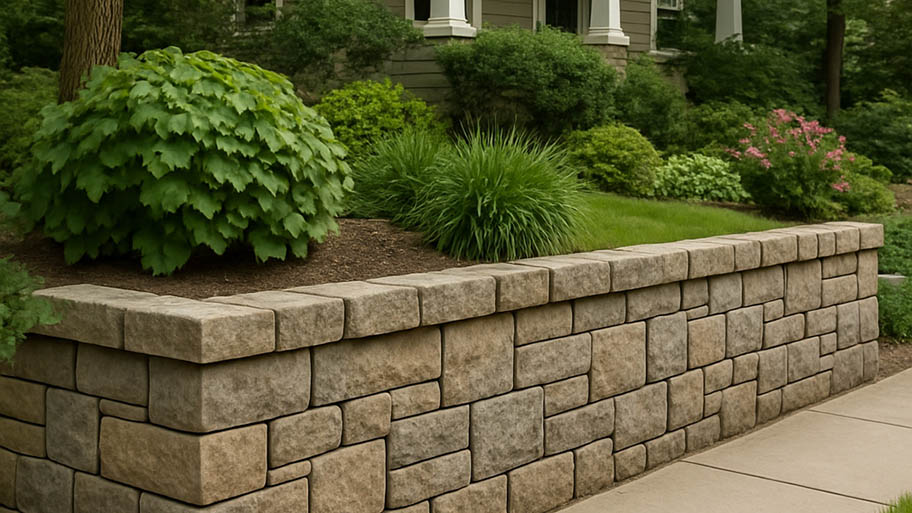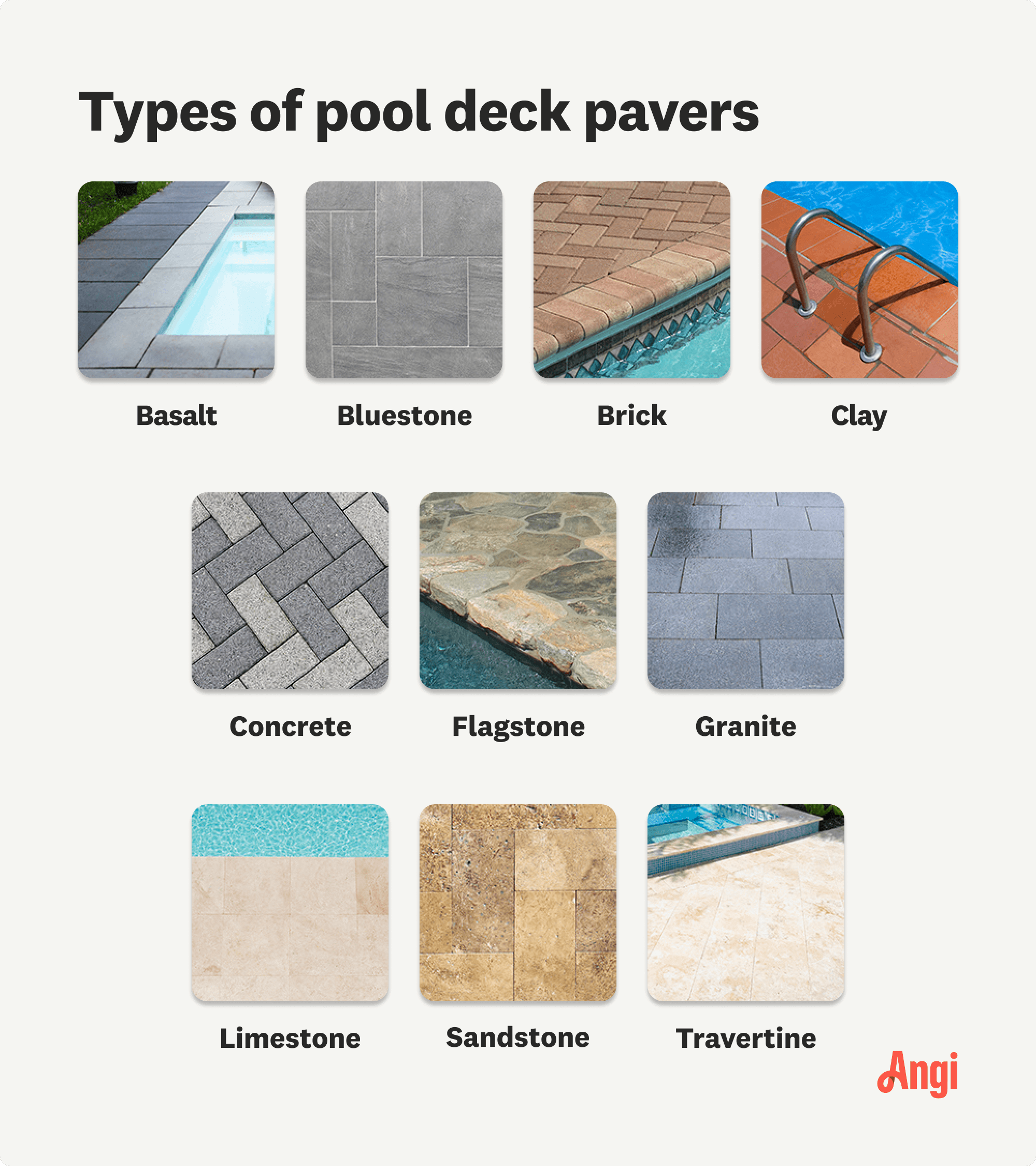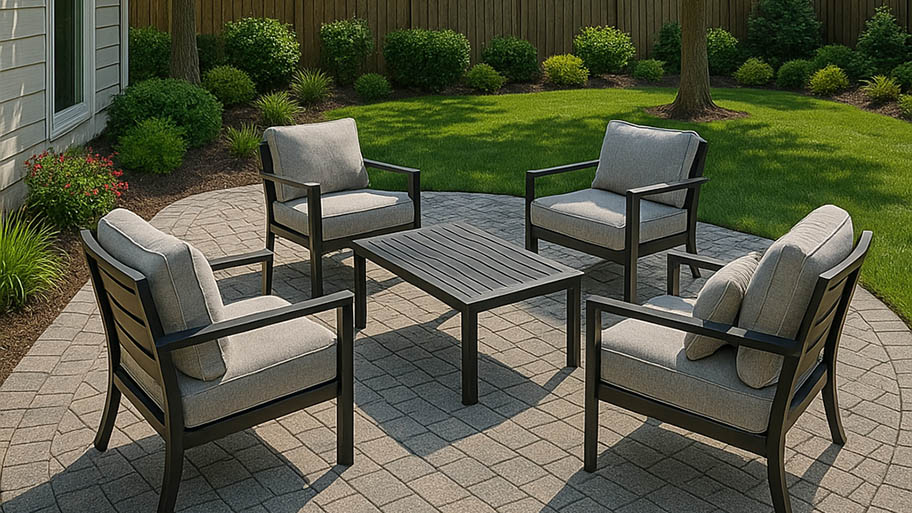
Kick erosion to the curb with an eye-catching retaining wall. Retaining wall costs vary based on the material, but this guide will help you budget.
Pave your way to the perfect pool deck


There are 10 popular types of pool deck pavers.
Installing pavers around your pool is a DIY-friendly project.
Paver prices range widely, from $3 to $50 per square foot.
Pavers come in a variety of materials, shapes, colors, and textures.
The hardscaping surrounding your pool helps provide a slip-free surface so your family can safely enjoy the water. Pool deck pavers are a perfect way to accomplish that—while also looking beautiful. But is a paver pool deck right for you?
Pavers are among the least expensive and most stylish pool deck materials, as they come in a wide array of materials, shapes, colors, and textures. Like the pavers in a driveway or walkway, these slabs fit together to form a smooth surface and define the appearance of the pool area and its transition to the surrounding landscape. Here’s what to consider when selecting pool deck pavers to create a stunning design before you contact a hardscape contractor near you.
Pool deck pavers are a great choice because they’re incredibly durable in the face of salt water (perfect if you have a saltwater pool), as well as foot traffic. Because of their complex surface, they also offer more slip resistance than other deck options, keeping your poolside fun out of the clutches of excessive safety hazards.
In most cases, you can’t go wrong by choosing pool pavers. The only catches are the type of material you choose and how well you maintain your pavers. On the other hand, pool pavers aren’t always perfect. There are several disadvantages to pool deck pavers that you’ll want to consider before making your decision.
Here are the pros and cons of pool deck pavers to help you decide if pavers are right for you.
| Pros | Cons |
|---|---|
| Easier to repair and replace | Weeds can pop up |
| More material options | Each paver’s appearance can vary |
| DIY-able | Period resealing may be needed |
| Long-lasting | Stone options are very expensive |
| Better drainage | Too much traffic can cause the surface to be uneven |
| Don’t have to deal with the curing process |
Manufacturers produce pool deck pavers in many different materials, and each has pros and cons that may influence your decision on which to use. Here’s how each type of pool paver material compares.

Made from durable natural stone, basalt pavers come in shades of gray and black, offer a unique texture, and come with a one-of-a-kind finish.
Basalt Paver: $15–$30 per square foot
| Pros | Cons |
|---|---|
| Durable | Stains easily |
| Mold- and mildew-resistant | Harder to clean due to its high porosity |
| Sleek, neutral, and versatile appearance | Limited color choices |
| Easy to install | Inconsistent appearance between the tiles |
| Antibacterial | Needs regular sealing |
Bluestone is a natural sedimentary stone that looks sleek and uniform. You can lay bluestone pavers to create an elaborate design of the utmost sophistication and style.
Bluestone Paver Cost: $15–$30 per square foot
| Pros | Cons |
|---|---|
| Wide variety of sizes and shapes | Higher cost than most other natural stone materials |
| Stunning, modern appearance | May get slippery when wet |
| Long-lasting | Lacks heat resistance |
| Withstands freeze-thaw conditions | Requires sealing periodically |
| Absorbs water and flakes away if not sealed | |
| Susceptible to erosion | |
| Difficult to install |
Brick pavers around pools provide a classic look with hues of bronzy orange, dark gray, beige, and brown. You’ll find that brick consists of a few different mediums, including clay and concrete.
Brick Paver Cost: $8–$50 per square foot
| Pros | Cons |
|---|---|
| Durable | Absorbs heat, making it hot in the summer |
| Variety of styles and sizes | High maintenance |
| Easy to customize | Prone to moss, mold, and algae |
| Comfortable surface for walking | Needs sealing every three to five years |
| Environmentally friendly | Higher long-term maintenance costs |
Clay brick pavers come from fired clay, making them a durable, orange material that contrasts nicely with pools of all shapes and sizes.
Clay Paver Cost: $3–$5 per square foot
| Pros | Cons |
|---|---|
| Cost-friendly | Limited design choices |
| Warm aesthetic | Absorbs heat, making it hot in the summer |
| Low-maintenance option (doesn't require sealing) | Orange hues may clash with home’s aesthetic |
| Very durable | |
| Easy to repair or replace | |
| Corrosion- and fade-resistant | |
| Environmentally friendly |
Concrete brick might be a go-to pool deck paver material due to it being readily available, durable, and economical. This pool deck paver’s light gray, beige, or orange appearance makes for a popular choice, but here are the pros and cons of choosing concrete pavers to help you decide if it’s the right one for your yard.
Concrete Paver Cost: $5–$15 per square foot
| Pros | Cons |
|---|---|
| Cost-friendly | Less slip-resistant than other options |
| Versatile shapes, colors, and sizes | Prone to cracking |
| Durable | Susceptible to surface erosion |
| Water-resistant | Colors might be hard to match and make uniform |
| Withstands freeze-thaw conditions | Prone to fading |
Flagstone pool decking pavers offer stunning pops of colors ranging from beige to gray to orange to purple, making the material an excellent choice for a natural-looking deck. Derived from plant matter and sand, this material has a lower carbon footprint than many other options. Bluestone, limestone, quartzite, and sandstone are all types of flagstone materials.
Flagstone Paver Cost: $15–$30 per square foot
| Pros | Cons |
|---|---|
| More cost-friendly than some other stone options | Lacks heat resistance |
| Durable and long-lasting | Rustic appearance may clash with modern aesthetics |
| Crack-resistant | Stone quality varies by location |
| Resistant to temperature changes | Uneven surface may make furniture wobble |
| Low-maintenance | Harder to install due to uneven thickness |
Granite pavers are non-slip natural stones that come in light grayscale shades that you can mix and match in gorgeous combinations.
Granite Paver Cost: $20–$50 per square foot
| Pros | Cons |
|---|---|
| Slip-resistant | High upfront cost |
| Extremely durable | Heavy and harder to DIY |
| Water damage resistant | |
| Low stain appearance |
One of the world’s most common building materials, limestone makes for earthy-looking pavers that match with pool coping of the same material.
Limestone Paver Cost: $15–$30 per square foot
| Pros | Cons |
|---|---|
| Cost-friendly | Requires occasional sealing |
| Low-maintenance | Can chip if not sealed |
| Mold- and bacteria-resistant | |
| Natural appearance | |
| Can be shaped into custom designs |
Sandstone pool pavers offer light earth tones of beige, white, and hints of orange that add a natural and effortless look to your pool, but that’s not all. Here are some pros and cons of sandstone pool deck pavers.
Sandstone Paver Cost: $10–$30 per square foot
| Pros | Cons |
|---|---|
| Cost-friendly | Porous and prone to water damage |
| Wide variety of shapes | Can stain and warp |
| Warm, earthy tones | Susceptible to scratch marks |
| Heat-resistant |
Travertine is a light-colored and porous stone that can make any pool feel like a luxurious, Mediterranean paradise. If you want a pool deck paver with beige and grayish tones, this may be your ideal material of choice.
Travertine Paver Cost: $5–$25 per square foot
| Pros | Cons |
|---|---|
| Durable | High maintenance requirements due to porousness |
| Resists freeze-thaw cycles | Requires sealing every three to five years |
| Non-slip surface | Higher price range |
| Heat-resistant |
There’s no way around it—installing pool deck pavers is a big investment. As such, you’ll want to feel confident in your paver material of choice before you buy. Consider these six tips to help you pick the right pavers:
Take into account your landscape and which pavers will add to the natural appearance of your property and landscape design.
Consider what shape and size you want for your pavers to help you decide on the best material.
Avoid choosing a highly porous material if you have kids or dogs that will make lots of splashes.
Know the dimensions and size of your pool decking to estimate total costs and determine if your pavers will fit within those dimensions.
Consider your location and avoid choosing dark, heat-absorbing materials if you live in a hot region.
Weigh how much time you have to commit to maintaining your pool deck before you opt for a high-maintenance material.
Installing pool deck pavers can be a fun, albeit labor-intensive, process. If you’re installing pavers for a small pool deck—and have a few helping hands—DIYing the project could save you money. Here’s how you can DIY your pool deck paver installation.
Create a design: You need a blueprint for laying the pavers to help you calculate how much of each material you’ll need.
Gather your materials: Necessary materials include pavers, an excavator, a tamper, landscape fabric, a gravel base, paver sand, paver edgings, and sealant.
Check before you dig: Make sure there aren’t any buried lines before you excavate.
Excavate the site: You’ll need a level surface to install pavers so that they don’t shift or come loose over time.
Tamp your base: After the excavation, solidify your foundation by tamping the dirt.
Place down your weed barrier: Keep weeds from popping out between your pavers by laying landscape fabric.
Add gravel: Use a shovel to scoop gravel on top of the weed barrier. Rake it until the surface area is level, then spray it lightly with water and tamp it down.
Pour the paver sand: Pour a thin, level layer of paver sand on top of the gravel.
Lay your pavers: Place each paver down individually, creating the pattern of your choice.
Add paver edgings or edging stones: Keep your pavers from shifting by installing paver edgings to the outer perimeter of your new deck pavers. Secure the edgings by hammering stakes down with a rubber mallet. Alternatively, dig a trench, sprinkle sand at the bottom, and lay edging stones around the perimeter to hold the pavers in place.
Add more sand: Sprinkle a thin layer of sand on top of all of your pavers, using a push broom to ensure the paver sand reaches every nook and cranny.
Seal the pavers: Depending on the type of pavers, you may need to apply a sealant over the deck pavers using a roller.
Even after you choose a pool deck paver material, there are many stylistic approaches you can take to turn your pool deck into the best design for your yard.
As you weigh the pros and cons of different kinds of pavers, think about how the pool area sits within the context of your yard and your house. Choose pavers that enhance your outdoor area’s natural beauty and complement the look and feel of your landscape design.
For example, brick pavers might not be the best choice for a minimalist, modern home, which might be better served by the industrial quality of concrete pavers.
While some pool decks blend seamlessly with their environment, others catch the eye by emphasizing the contrast of the crisp, blue pool water—in the same way that patio pavers can reshape your landscape. The shape is often the major factor, with the pavers taking a sharp, geometrical rectangular form or a flowing, organic oval. Don’t be afraid to be playful, but ensure you think deliberately about how the deck fits within your overall design.
If you’re feeling torn between pavers and another style of pool decking—like poured concrete or tile—or among different styles of pavers, don’t forget that you can create a stylish pool area with mixed materials. Create striking patterns or a sense of variety by combining different shapes, textures, and materials.
The warmest months are the busiest for your pool area, and your deck will absorb heat from the beating sun all day. No matter how tempting it might seem to establish a sleek look with a dark-colored deck, you don’t want your pavers to burn sensitive feet and scare your guests away.
Light paver shades and materials like limestone and marble offer the best protection against the sun. More absorbent colors and materials like brick, granite, or bluestone are best kept as accents in pools that receive direct sunlight. Don’t forget that the pavers will get darker when they’re wet.
Pavers come in a wide range of sizes, and your size choice will play a big role in the impression made by your deck. Smaller pavers create a dynamic sense of visual interest, breaking up the space and entertaining the eye. Larger pavers impart a more organic, spa-like feel, giving the deck a smooth, sophisticated sheen.
There are pavers in almost every shape imaginable—and even where existing options fail, you can always get custom designs produced. Square and rectangular pavers are the traditional choice, but in recent years, long, wood-style planks have come into vogue. Manufacturers also sell bundles of pavers in three different shapes so that you can create a unique pattern for your home.
Whatever the style, pavers need a penetrating sealer or surface finish to resist staining, fading, and damage from threats like spilled food and drinks, algae, pool chemicals, and patio furniture. To maintain the appearance and lengthen the life span of your pavers, make sure to reseal them every three to five years.
From average costs to expert advice, get all the answers you need to get your job done.

Kick erosion to the curb with an eye-catching retaining wall. Retaining wall costs vary based on the material, but this guide will help you budget.

Looking to elevate your backyard aesthetic with a patio? Use this paver patio cost guide to help you estimate your total project cost before you get started.

Porcelain pavers are a high-end option for your home’s hardscaping that can completely transform your outdoor space. Here’s how much porcelain pavers cost.

If you’re looking to build a brick pathway or patio, there are lots of walkway patterns to choose from. Here’s a list of the most popular designs and types.

Looking to beautify your outdoor area with a walkway? Use these stepping stone walkway ideas for inspiration for adding a bit of tranquility to your space.

Have you noticed your pavers sinking or would you like to forget about the stains on your driveway? Here are common paver problems and what to do about them.